Thought long and hard about whether to open up this topic. As I had the information I thought I would give everyone the evidence and let you decide.
Hi all
Well it has been interesting to say the least some off the comments in relation to the colour scheme of the Fw190A-5 1227. Firstly, it was lost with 4./JG54.
It is a project that I have followed for the last 20 years. For the first ten years when it was owned by Doug and David Arnold I followed it extensively, seeing it following the recovery and when the restoration began down in Bournemouth during 1992 or so. I heard it was purchased for £250k as was in 1992.
During this time, I went and saw the airframe and restoration every 2-3 months, staying there the whole day and taking numerous photos and notes. Photos were taken of the airframe, systems, colours, demarcation lines – everything which was of interest. I was an enthusiastic amateur. I also then photographed the restoration of the wing and tail unit which was a treat in itself.
We got Authur Bentley on board (part of the Classic Publication group) who is a former BAe engineer and an expert on WWII and especially the Fw190 (and an amazing line drawing artist). He had a lot of the technical/construction information in relation to the A-5 model and designed the wing jig as well as drawings in relation of the new main spar caps. The wings were restored with very little new material – new spar caps, one casting, one new rib and one rib repaired. The leading edge was new and was copied from the Fw190 S-8 at Hendon. Authur has gone on to help White 1 and Flugwerk with there Fw/FW projects. Not sure what any of these groups would have done without him.
The canopy came from the bottom of the lake, so the Perspex is 1940’s original.
Additionally I undertook a lot of research on the pilot with the help of Axel Urbanke in Germany. The pilot survived the crash landing and became a POW – returning to Germany in 1949. Paul Rätz died in 1989. We managed to get the detailed loss reports, the son had photos and log book entries. Paul Rätz started as a ground crew member before becoming a pilot. He flew with 1./JG54 for a year 1942-43 and flew with Nowotney. He had three crash landings, had air to air victories, Frontflugspange (Front line flying clasp (you need to complte over 110 to get Gold) in bronze, silver and gold. He was best known as a ground attack pilot hence why he was transferred to 4./JG54 on 9th July 1943. Ten days later, the BMW 801 suffered a catastrophic engine failure. Attacking a train there was Flak but none located on the airframe. The engine is thought to have been sabotaged during manufacture. It crash landed in a sapling forest which then grew around the aircraft so that 40 years later you could not see it from 20 feet away.
The recovered airframe was 99% complete. It was missing two MG-17 machine guns, a few instruments and the master compass. Ammunition boxes were still there was well as the remains of the pilot leather skull cap on the seat.
The main plate showing 1227 April 1943 was saved and 1227 was found on a triangular plate on the fin. Two parts in the aircraft had other W.Nr’s – the battery cover was painted ‘Fw190 W.N1237'. One of the cannon ammunition boxes had ‘689’ (A-4?)
When sold to FHC they took over the restoration and using all of the resources at their disposal to restore the aircraft to as she was in 1943. Whereas the Arnolds had replaced the wing skins, JME (the company tasked with undertaking the restoration for FHC) reused the existing wing skins and went on to do the same on the fusealge. Other areas were rebuilt to a higher standard and damaged elements not fitted originally were repaired and refitted. The tail unit skins also original. The only real new build was to the tailplane. The quality of work undertaken by JME is second to none and FHC has the advantage of having a seemingly unlimited budget. JME – a worldclass team of Jeremy, Bruce and team must be applauded for the work they undertook.
When it moved to JME, I did manage to see her a few times but it was no a lot further away. All of my photos were provided to JME to assist them with the project. It is always difficult picking up a project when they were not involved in the outset and did not see how she looked to start with.
The airframe then went to the States to be mated with the engine. The engine restoration was started by JN before it went off to Mike Nixon at V12. I have heard six BMW engines were used to rebuild the one flying engine.
All in all, I have heard the project cost between $7-$10M – pick your number!
Towards the end of 2010 I heard that the project was nearing completion and offered my help. Photos were sent to Vintage V12 to assist them with the engine/airframe connections/plumbing routes. Mike has done a fantastic job.
I discussed the project with 2 members at FHC and offer to help then with the paint scheme, demarcation lines, national markings etc. It must be remembered, FHC are a museum/collection and generally rely on expert in all the field of WWII aircraft, tanks etc. They do not have in depth expertise in house on every one of there exibits.
I offered to help, possibly for a small fee - $1000 or so, or a flight to AZ/WA to see the first flight and/or possibility to write about her – recovery/history/restoration/first flight. This was refused – FHC indicating there was nothing in the budget to pay for a flight and they might help with an article but another magazine had an exclusive first. (but no connection to the aircraft).
I originally thought, OK I will leave it up to FHC but then found out that they had the four view scheme I marked up in 1995 showing the demarcation lines etc. Though it was never officially released to them, his was going to be used for the basis of the paint scheme. They also had the side view by Kjetil Aakra and commissioned by me – posted it on the FHC website – originally without acknowledgement to either of us.
FHC were going to base the A-5 stencilling on the F-8's at the NASM and White 1 in Florida. I am sure most of you will know the difference between these models, especially in the date of manufacture! I can confirm this was all being undertaken by someone within FHC.
Anyway, in the end I assisted FHC just for the love of the aircraft and to ensure to the best of my abilities that it was finished correctly. I had a few late nights sending through a paint colour scheme four view – highlighting stencils location sizes and also national marking sizes and locations for the four main colours and theatre markings.
Ah, onto the colours.
For the last twenty years and with all the photos I have of 1227 before restoration, the colours to me have always been sand, brown and dark green. In 1990’s, I sent Ken Merrick photos for his research/publication ‘Luftwaffe Camouflage and Markings 1933-45’. Ken is generally accepted as the expert on Luftwaffe colours.
Just prior to the publication of the two volumes, it seems documentation had come to light confirming the pre war colours RLM61, 62 and 64 were being retried and tested and given new numbers. This is thought to be new information – for the 1990’s!
RLM81, 82 and 83 were thought to be tested by JG54 and maybe JG51 in the field and in August 1943 were ready for issue and are generally known as late war colours. I suppose the thought originally was that these were to be Luftwaffe colours for the Northern Sector (Leningrad etc) before the retreat. At this time Soviet air attacks were become common place.
From this and matching with photos etc, it is thought that the colours applied to 1227 were RLM79 (Sandgelb), RLM81 (Dunkelbraun) and RLM82 (Olive Grün) and/or RLM83 (Dunkel Grün)
The factory scheme is clear cut RLM74/75/76. The underside factory 76 was Licht Blau.
Besides the upper colours, the lower surfaces were also repainted in the field. Two blues were clearly visible on the airframe. The lower RLM76 Light Blau (more blue) had been overpainted with a lighter RLM76 (yes same code) RLM Grau Blau (greyer). It was known to be applied to the whole undrside as it was a uniform colour when the ground crew overpainted the G and H factory codes under the wings (Factory codes of DG+HO – the H and O were painted over by the yellow theatre markings at the wing tip).
The seemingly unusual light olive green to the rear yellow band shown on the photos by the tail unit was recorded by Ken as being RLM62 and the only visible area this was seen is to the yellow fuselage band (port side) and possible a few wisps to the tail plane. This might have been applied solely to the old theatre marking - repositioned by JG54.
It has been suggested the original colours were not recorded - this is not true. In the mid 1990’s a warbird painting company in the UK with the help of Glaserit – did a spectroanalysis of these surviving colours. (I had the two lower tail skins in my kitchen for a few weeks and my wife was not too happy). This was recorded and a paint swatches produced. (Trouble is, this was 15 years ago). Having been protected by the tailplane, these areas had suffered the least from UV degradation or weathering. The warbird painting company was approached by myself in late 2010, I forwarded info to the FHC and the company were in the process of located the chips just before xmas 2010.
My suggestion to FHC , was not to rush, to get paint samples of the RLM colours and paint squares of aluminium and assess them in relation to the photos before the restoration commenced on 1227.
In addition, I sent through these links of RLM colours. Although I would not suggest using the FS codes, the RLM colours they produce (albeit on the web) do look a very good match when looking at the original photos. It was a guide, if nothing more.
My unpaid recommendation to FHC was that the colours could have been RLM76 grau blau, RLM79 sandgelb, RLM81 Dunkelbrun and RLM82 Oliv Grun. The paint comound, paint thickess and spray techniques all needed to be assessed.
I personally, do think that it was all too rushed at the end and not enough paint samples completed and assessed. When the first photos was sent to me I did not think it looked too bad. It was in low light, in the hanger and not direct sunlight. In the bright sunlight of AZ, the colours look a lot more garish, so the sun really does not help. Hopefully the rain and greyness of Seattle will help. FHC assured me samples were taken from surviving corroded skins (tailplane) not reused on the restoration. This area was heavily weathered and had field colours over factory colours. Only the RLM79 was clearly visible and this seems correct on the restored airframe.
The RLM76 to the underside looks fine also. The brown (whichever code) seems to have become more green and the dark green (olive green) seems to have become very light. The yellow also looks more like RLM27 (Tactical marking yellow) and not RLM04. (Theatre marking yellow)
Colours I sent through to FHC
The Federal Standard 595 Color Server <file:///> is a Internet service devoted to providing information about colors in the FED-STD-595B specification.
Dear (Omitted)
This one is with the lighter RLM76
http://www.colorserver.net/showcolor.as ... 73&size=xl This one is with the darker RLM76
http://www.colorserver.net/showcolor.as ... 14&size=xl Colours look good.
Eastern Theatre markings
http://www.colorserver.net/showcolor.asp?fs=33538 Oxygen
http://www.colorserver.net/showcolor.asp?fs=35053 Red trim tabs / markings
http://www.colorserver.net/showcolor.asp?fs=31302 Fuel triangle
http://www.colorserver.net/showcolor.asp?fs=33655 Black - National markings
http://www.colorserver.net/showcolor.asp?fs=37038 White - National markings
http://www.colorserver.net/showcolor.asp?fs=37875 RLM74
http://www.colorserver.net/showcolor.asp?fs=36081 RLM 75
http://www.colorserver.net/showcolor.asp?fs=26132 Factory scheme colours of Fw190A-5 1227 (With lighter RLM76)
http://www.colorserver.net/showcolor.as ... 6132+35622>
It would probably best to get sample pots/swatches of the above colours and start marking up some spare aluminium skins. If it looks right against the photos I am sure it will be right.
Regards
Mark
So I would not say I am a lay person with this regards. Just an amateur with 20 years experience on this aircraft. I am not saying that my proposals were absolutely 100% correct and I am not saying that the FHC scheme is 100% wrong. The demarcation lines I sent FHC are basically correct and the same seem to be for the national markings and White A.
I’ll let everyone else decide. After 20 years for the restoration, I wish there had been a bit more of a lead in before FHC painted the airframe. The 1227 paint swatches could have been found, experimentation with colours and co-ordination with photos etc could be assessed. Then perhaps a number of people could have agreed with the best solution and the way to proceed. The non standard field colours were there to match and copy.
It might then have looked a bit different.
It as always intended as a possible book project.
The recovery by Rupert Wilbraham in 1989-90 was a story in itself - two groups, aircraft 'mined' and disassembled and spread around he forest.
The history.
How the pilot survived his incarnation is another – how he survived not being shot by a Soviet soldier who wanted his watch (he smashed it against a tree) when captured, how he got to have the clock from 1227 (the family still have), how being an electrician had its benefits in the POW camp and assisted in his survival for the next 6 years.
The restoration
By a passionate set of individuals, Authur Bentley, Bob and Simone in Bournmouth, Jeremy, Bruce, and team at JME, JN, Mike Nixon and team at Vintage V12’s and Dave Goss and team at Goss hawk – probably with the most difficult task. FHC must be praised fro restoring this priceless artifact.
As for the photos/profiles, thanks must go to Kjetil Aakra for assisting me with these.
Profile 1 – Fw190A-5 1227 DG+HO in factory finish.
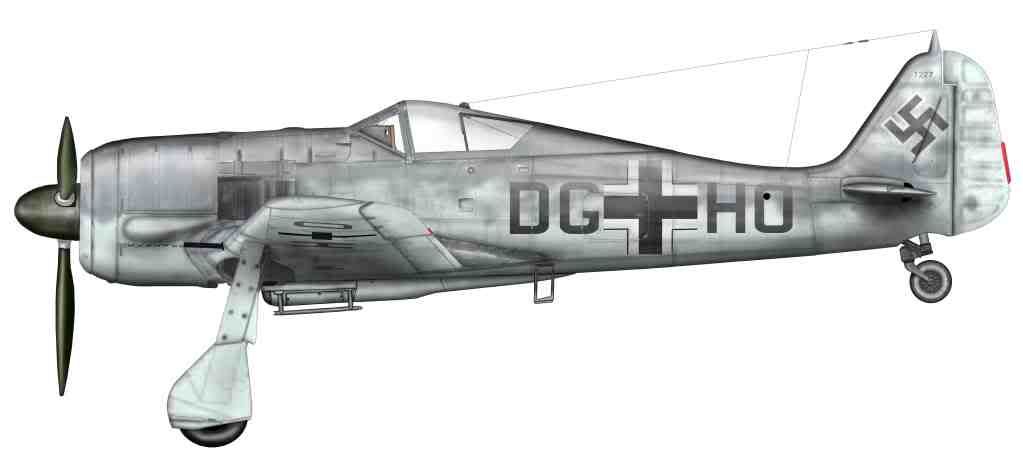
Profile 2 – Fw190A-5 1227 DG+HO delivery scheme to Eastern Front.
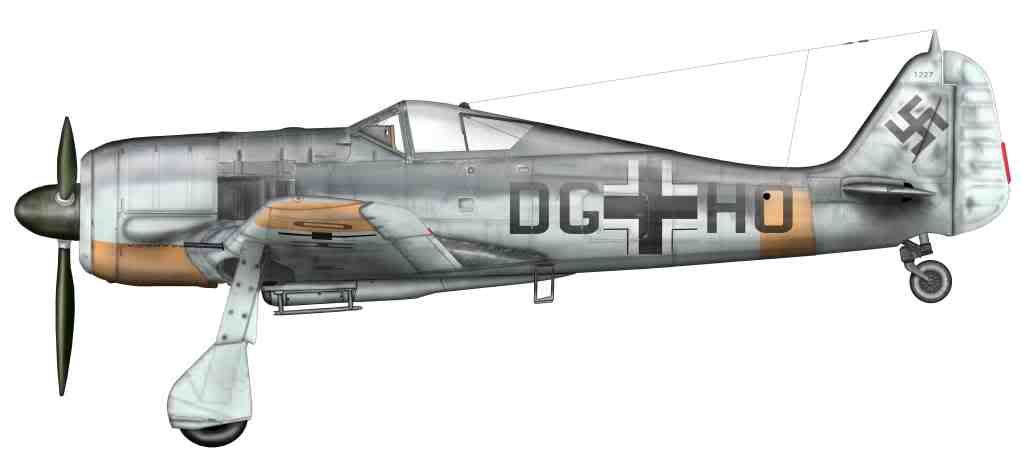
Profile 3 – Fw190A-5 1227 White A with 4./JG54
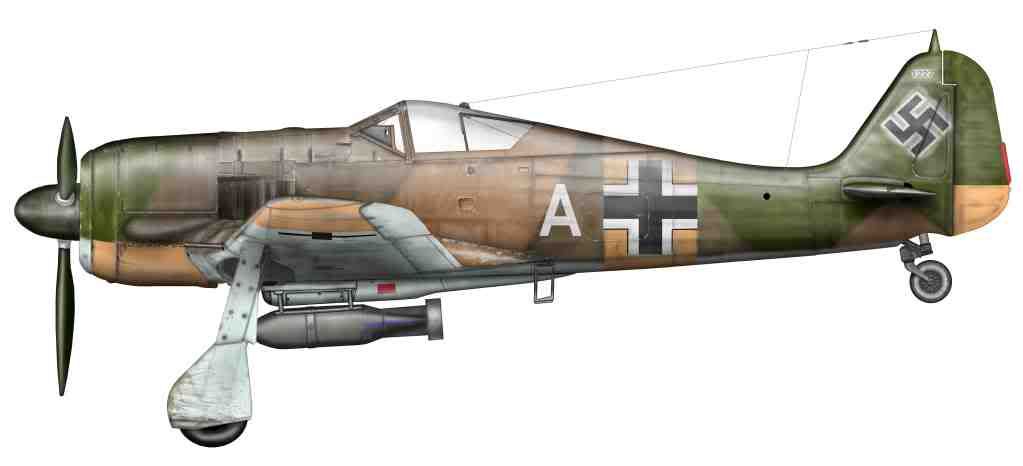
Scans form Classic publications.
Photo showing White K and WhiteB/D of 4./JG54. Unfortunately demarcation lines are not visible.
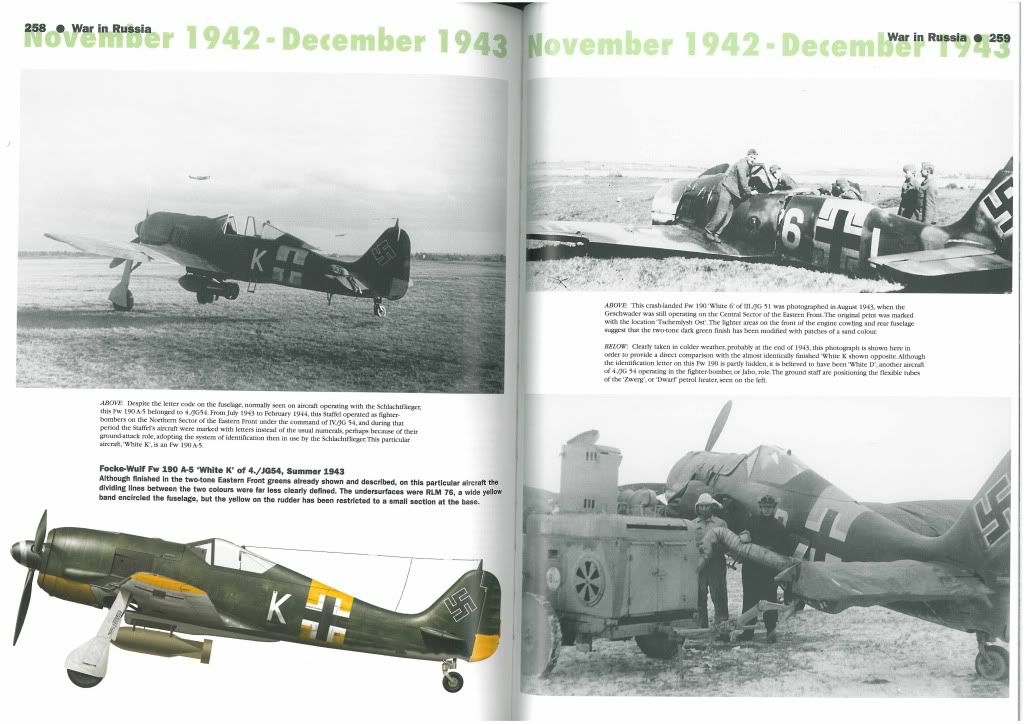
Scan of Fw190A ‘Brown’ 8 of JG51 with a similar scheme. The profile is shown as two greens though could easily be RLM81/82.
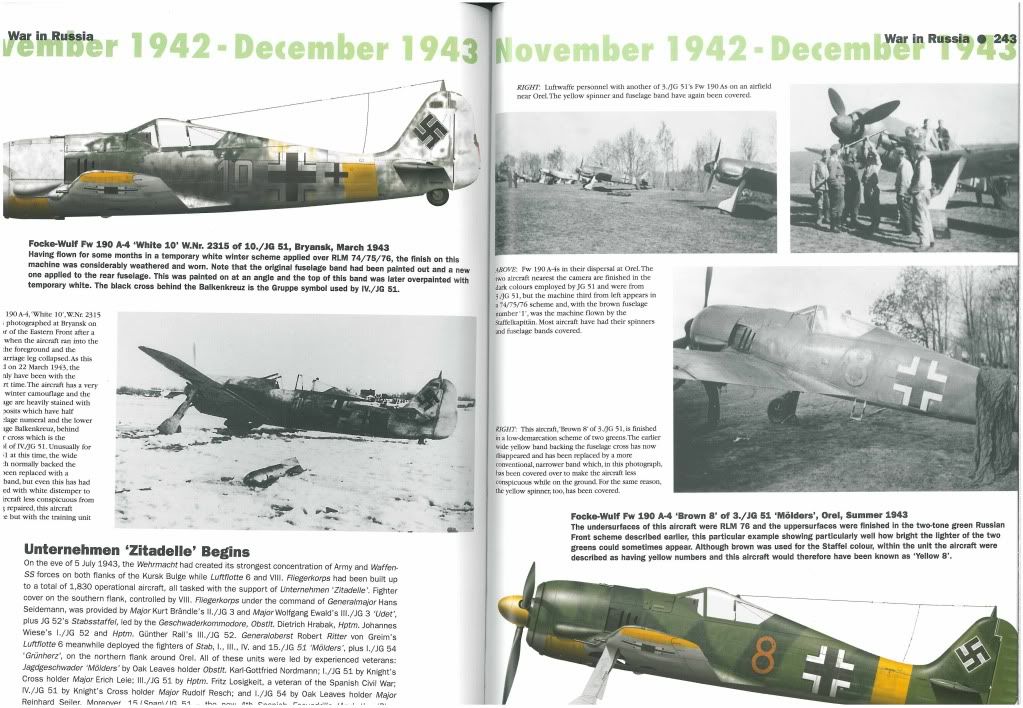
It is known 1227 was not issued new to 4./JG54. 4./JG54 received 12 'used' airframes in June 1943. These were probably coded White A, B, C, D, E, F, G, H, J, K, L, M. (White I not used as confusion with 1). Photo of White B/D and K are known. White A, B and D were lost. It is thought 1227 may have come from JG51. It is also possible 1227 was painted by JG51 and not JG54?
Photos of how she was.
Fuselage in hanger.
Fuselage RLM82 on the left, RLM81 to the centre either side of the cross and the unusual (RLM62?) over the yellow band on the right. The yellow band around the cross was painted by hand.

Hatch
The RLM79 is clearly visible as is the RLM81 Dunkel braun. The yellow is RLM04 and a lot darker.
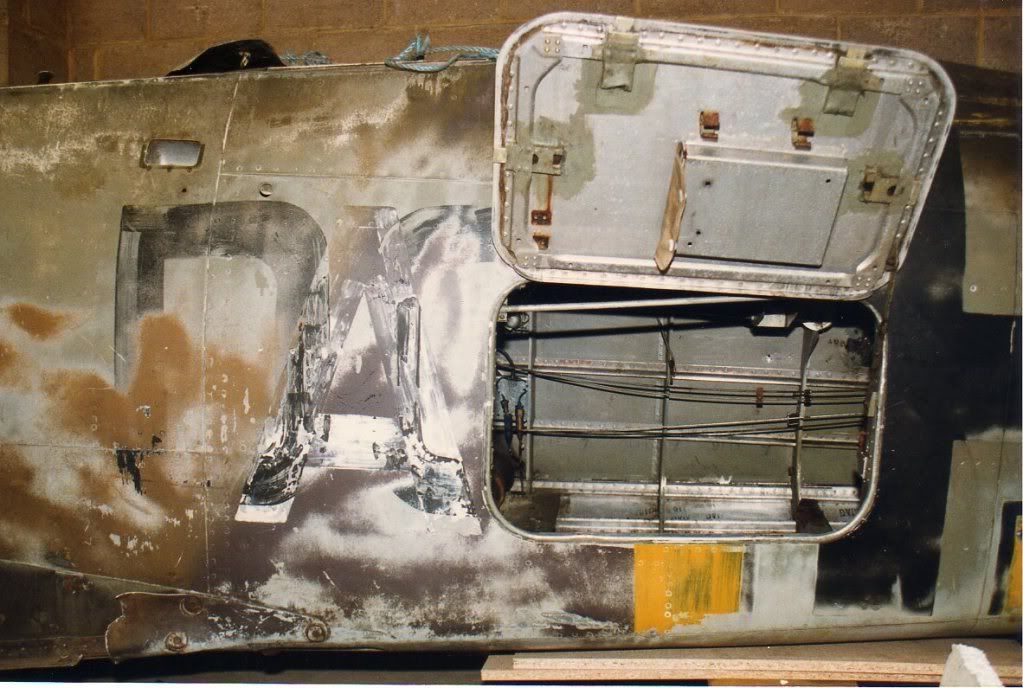
Tail
These lower skins below the tailplane were the ones scanned and copied. The colours are unweathered and clear.
The rear fuselage shows the light green. The tail shows the RLM79 and the RLM81.
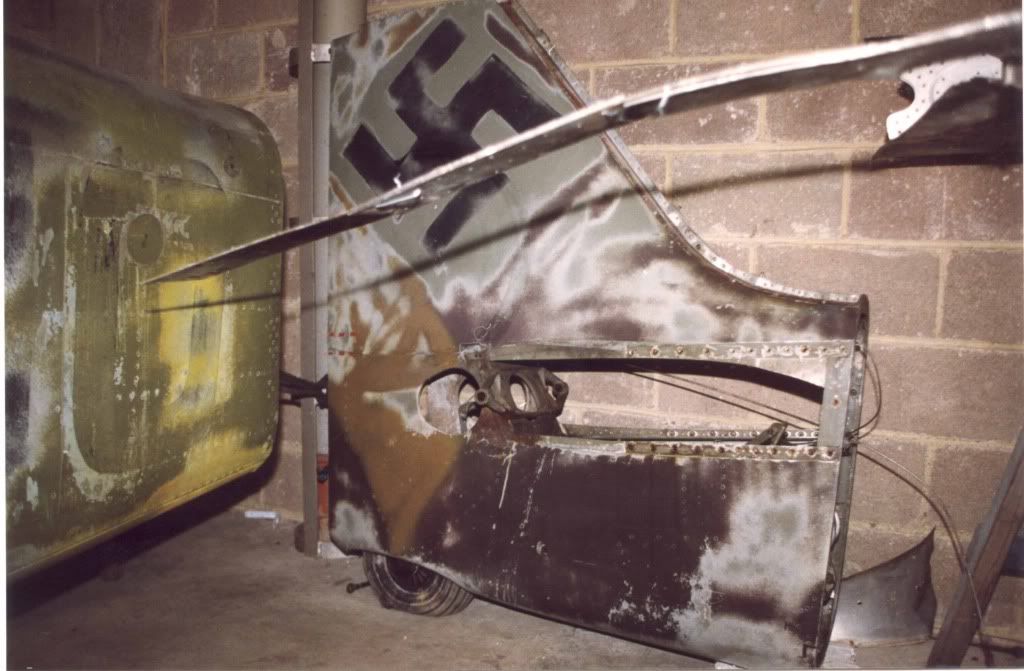
Tail
Sent to FHC to position swastika. The green can be seen to be darker and thought to be RLM82 – applied everywhere.
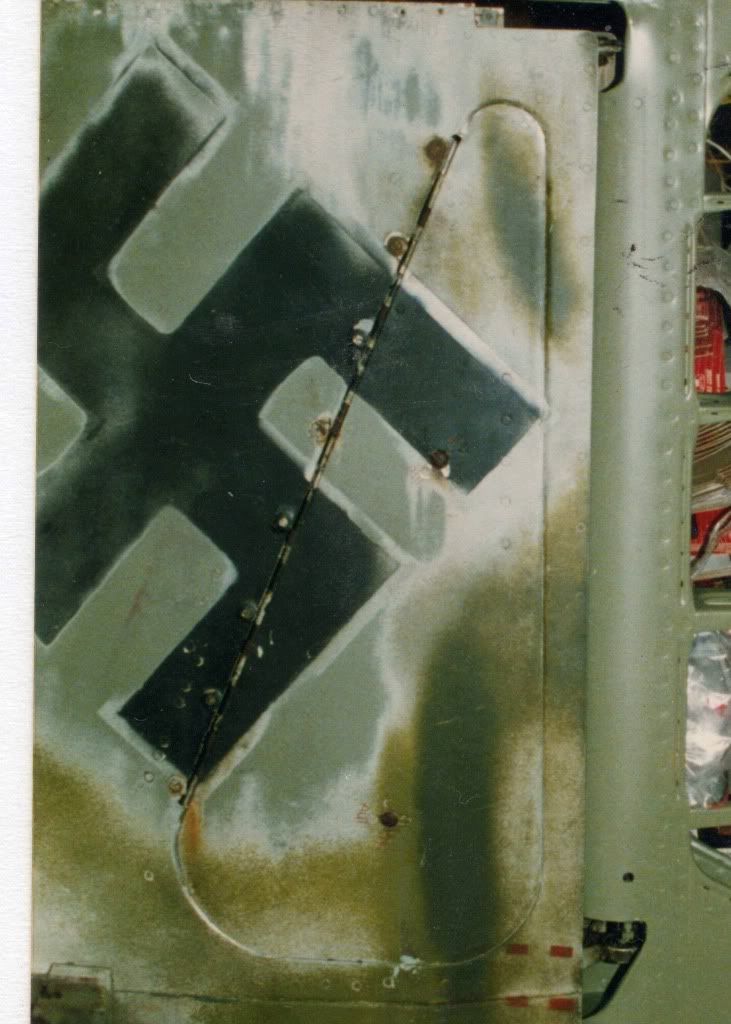
Wartime photo
Black 5 of sister unit 5./JG54 in the summer of 1943. The airframe is more mottled than 1227 but is painted with RLM02 RLM81, RLM82 and RLM83.
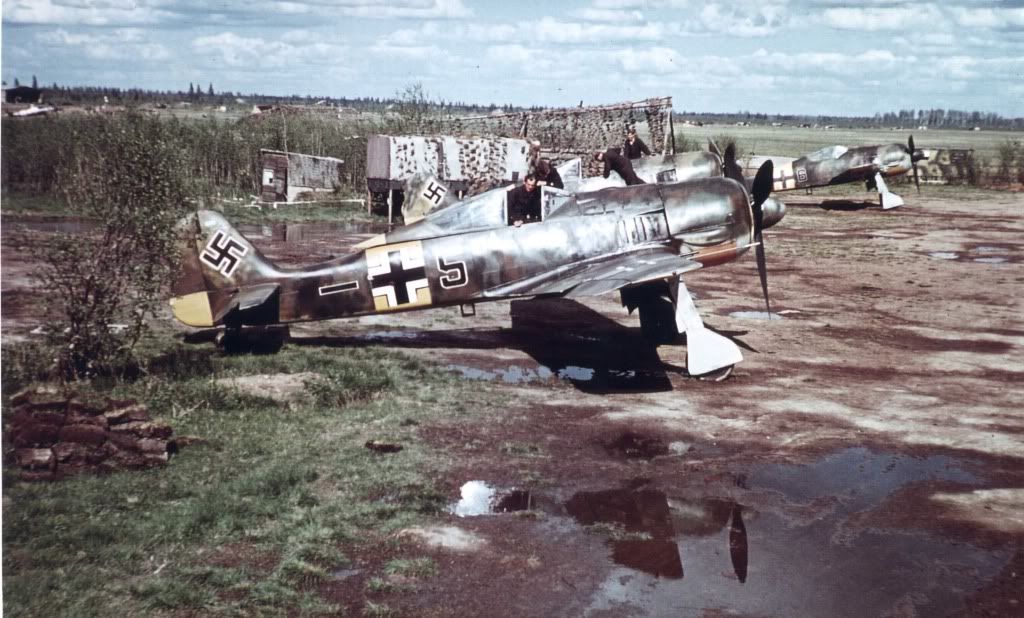
The reason why RLM81 (Dunkelbraun) and RLM82 (Oliv Grun) were used can be seen by what the ground the Fw190 is sitting on – brown and green.
Sounds like a confession. Feel a lot better now. Will be interesting see what questions this subject raises.
MS
MS





